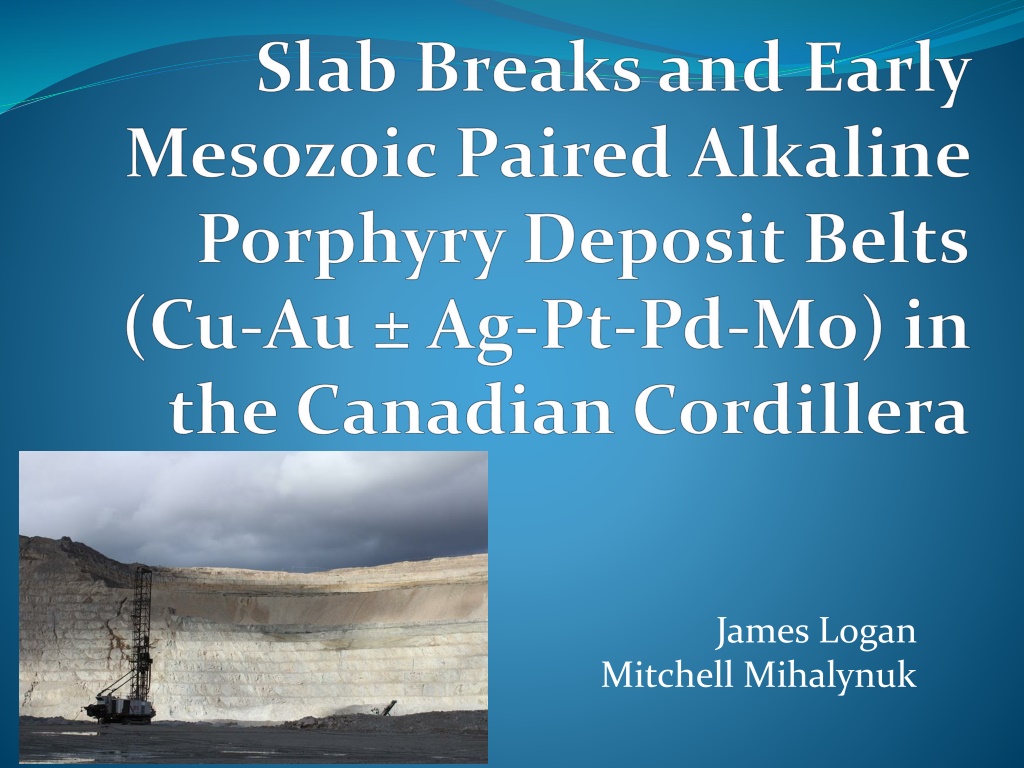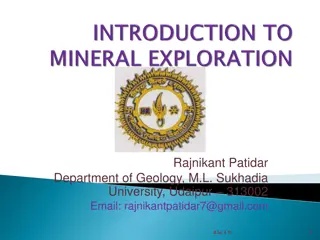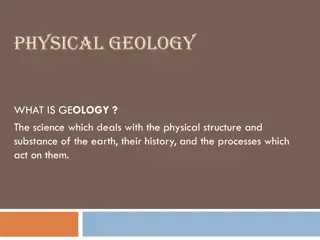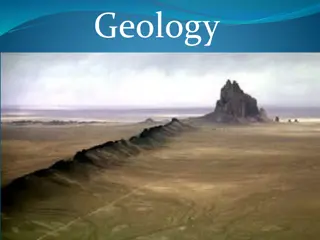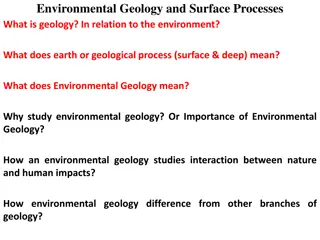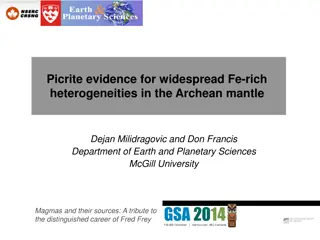Geology and Magmatism in Canadian Cordilleran Terranes
The content discusses the geological features of Cordilleran terranes in Canada, including the Stikine and Quesnel arcs, Cache Creek, Slide Mountain, and more. It delves into the relationship between magmatism, porphyry mineralization, and subduction processes, highlighting the Kutcho-Sitlika-Venables region and the chemistry of volcanic rocks. The text also explores the origin of alkalic melts and their role in the geological history of the area.
Download Presentation

Please find below an Image/Link to download the presentation.
The content on the website is provided AS IS for your information and personal use only. It may not be sold, licensed, or shared on other websites without obtaining consent from the author. Download presentation by click this link. If you encounter any issues during the download, it is possible that the publisher has removed the file from their server.
E N D
Presentation Transcript
James Logan Mitchell Mihalynuk
Cordilleran terranes Stikine arc Quesnel arc Cache Creek Slide Mountain Pericratonic Initial Sr 0.704 0.705 0.707 Yukon-Tanana/Okanagan Kootenay/Arctic-Alaska North American displaced & autochthonous (Armstrong, 1988) Canadian Cordilleran 0.707 0.705 Porphyry Deposits 0.704
Po Ages - Magmatic Belts St Qn
RelateL>-EJ magmatism and porphyry mineralization to stalled subduction of low density crustal welt (Kutcho-Sitlika-Venables) (Davies and von Blanckenburg, 1995; van de Zedde and Wortel, 2001) Shallow slab detachment generates a thermal spike (50o0C+) at mid lithospheric depths Picrite lavas produced via large degree partial melt - indicate a direct route from mantle to surface ~5-10 Ma later alkalic melts ( Cu, Au, Ag, Pt-Pd-Mo) from low degree partial melt of a broad region of metasomatized mantle wedge Rapid uplift of the orogen L>-EJ unconformity
Kutcho-Sitlika-Wineglass-Venables: Fragments of a Tethyan Permo -Triassic intra-arc LP - M> basalt, rhyolite, volcaniclastic rocks and tonalite 263 -237 Ma Nd, Pb & geochem data suggest tholeiitic affinity (Childe and Thompson, 1997; Barrett, 1996) Kutcho assemblage Schiarizza ( 2012) Low-density crustal welt within Cache Creek terrane
Chemistry volcanic rocks high T. high degree partial melt Lherzolite ( 40%, reflects rapid ascent w/out crustal contamination) Sample/Primitive Mantle Brown and Mussett, 1993
Alkalic Chemistry CIPW Norms 20 Lang et al.(1994) Alkalic Silica- undersat. Flow, intrusion Galore Creek N a O+ K O ( wt%) 16 Mount Polley Q Iron Mask Batholith 12 Sugarloaf dike Ajax West Silica- sat. 2 8 2 4 Subalkalic 0 C C 40 50 60 70 80 S L PH + Hy S L P A SiO (wt %) 2 Foid Low-degree partial melts metasomatised mantle Bootjack stock Mount Polley I-4 Galore Creek
L>-EJ Initiation of orogen uplift Unconformities - Nonconformities Hazelton Group U U NW Stikinia U EJ U L> U EJ Arc Exhumation L> Whitehorse trough Angular unconformity - subvertical Stuhini Group mudstones and Jack Formation at base of Hazelton Group (Henderson et al., 1992) Granitic clast content increases up-section older units comprised primarily of volcanic clasts (Hart et al., 1995)
Late Triassic collision of the Kutcho- Sitlika-Venables arc with the Quesnel- Stikine arc
Cross sectional representation of slab break and resultant thermal spike Isotherm contours 0 to 1800 0C (after van de Zedde and Wortel, 2001)
Cache Creek Stikinia - S N Quesnellia - N S Kutcho L M P K B B W P K C G A G H S F IAT Harper Ranch Stikine Assemblage MORB IAB IAB
Late Triassic arc initiation, mafic volcanism, and emplacement of calc-alkaline plutons of the Stikine (236 221 Ma) and Guichon (212 208 Ma) suites Arc magmatism changed abruptly along the entire length of the arc in response to mantle fusion initiated by slab tear and the ensuing thermal spike. Triassic magmatism culminated with intrusion of the silica-saturated and silica- undersaturated Copper Mountain suite (210 200 Ma; 206 200 Ma) With resumption of subduction, a second calc-alkaline to alkaline cycle began after an approximate 5- to 10-m.y. hiatus Calcalkaline magmatism (199 - 190 Ma) comprises intrusions of the Texas Creek suite in Stikinia and Takomkane -Wildhorse plutons in Quesnellia Silica-saturated alkaline magmatism (185-178 Ma) at Mt. Milligan and Lorraine is syn- to post-collisional coincident with collapse of the arc orocline against North American continental margin
A buoyancy-stalled subduction and slab-break model is a viable explanation that embraces the: Mesozoic stratigraphy magmatic episodes and calc-alkaline and alkaline mineral deposits of the Intermontane arc complex Thank you
